The Thermally Stable Antiscalant Market is estimated to be valued at USD 1.3 billion in 2025 and is projected to reach USD 2.4 billion by 2035, registering a compound annual growth rate (CAGR) of 6.5% over the forecast period.
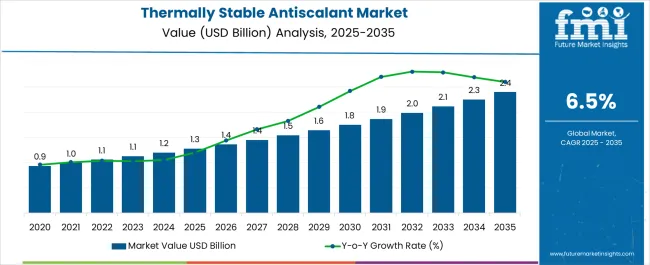
| Metric | Value |
|---|---|
| Thermally Stable Antiscalant Market Estimated Value in (2025 E) | USD 1.3 billion |
| Thermally Stable Antiscalant Market Forecast Value in (2035 F) | USD 2.4 billion |
| Forecast CAGR (2025 to 2035) | 6.5% |
The thermally stable antiscalant market is gaining strong traction, driven by the increasing demand for reliable water treatment solutions in industries operating under high-temperature and high-pressure conditions. These formulations are specifically designed to prevent scale formation in challenging environments, ensuring efficiency and extending the operational life of water treatment systems. The market is being shaped by the growing need for sustainable and cost-effective solutions in power generation, oil and gas, desalination, and chemical processing industries.
Rising global investments in water reuse and wastewater treatment infrastructure are further accelerating adoption. Stricter environmental regulations and the need for reducing operational downtime are encouraging end users to shift from conventional chemicals toward thermally stable variants that deliver consistent performance under extreme conditions.
Advances in chemical formulation and polymer technology are supporting the development of more effective products, enabling wider application scope With rising concerns over freshwater scarcity and industrial water demand, the market is expected to experience sustained expansion, supported by the push for efficiency and long-term operational reliability.
The thermally stable antiscalant market is segmented by type, application, and geographic regions. By type, thermally stable antiscalant market is divided into Thermally stable organic antiscalant and Thermally stable inorganic antiscalant. In terms of application, thermally stable antiscalant market is classified into Water and waste water treatment, Oil and Gas, Mining, Food And Beverages, Pharmaceutical, and Others. Regionally, the thermally stable antiscalant industry is classified into North America, Latin America, Western Europe, Eastern Europe, Balkan & Baltic Countries, Russia & Belarus, Central Asia, East Asia, South Asia & Pacific, and the Middle East & Africa.
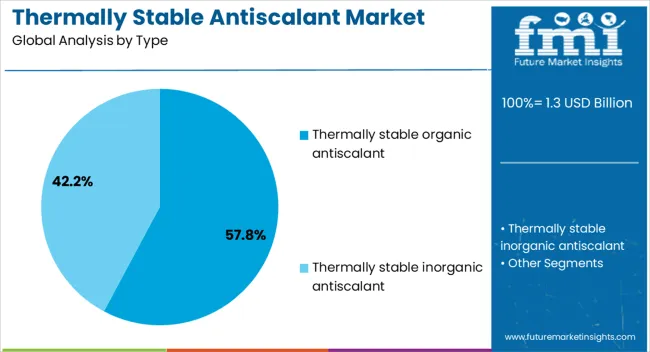
The thermally stable organic antiscalant type segment is projected to hold 57.8% of the thermally stable antiscalant market revenue share in 2025, making it the leading product type. This dominance is being driven by its superior ability to withstand high temperatures without degradation, ensuring effective prevention of scale deposits in industrial water systems. The segment is benefiting from its adaptability in diverse operational environments, particularly in thermal desalination plants, refineries, and chemical processing facilities.
Organic formulations offer strong dispersing and threshold inhibition properties, which improve system efficiency and reduce maintenance costs over the long term. Advances in polymer chemistry have enabled the development of organic antiscalants with enhanced resistance to fouling and precipitation, ensuring stable performance in extreme conditions.
Their environmental compatibility compared to inorganic alternatives is also contributing to their widespread acceptance in industries operating under strict sustainability guidelines As industries increasingly prioritize operational reliability and efficiency, thermally stable organic antiscalants are expected to continue leading the market.
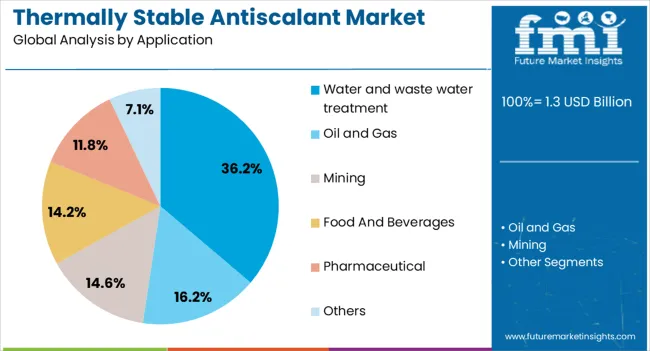
The water and wastewater treatment application segment is anticipated to account for 36.2% of the thermally stable antiscalant market revenue share in 2025, positioning it as the leading application area. This dominance is being supported by the rising need for efficient water management solutions to address the dual challenges of industrial water demand and environmental compliance. Thermally stable antiscalants are widely used in treatment facilities to prevent scaling in boilers, heat exchangers, and pipelines operating under elevated temperatures.
Their ability to maintain performance consistency reduces operational disruptions and extends the life of treatment equipment. Increasing urbanization, industrialization, and growing pressure on freshwater resources are driving investments in wastewater recycling and reuse projects, which in turn are strengthening demand for reliable scale inhibitors.
The segment’s growth is also being reinforced by government initiatives promoting sustainable water management practices and the adoption of advanced treatment technologies As global focus intensifies on circular water use and resource efficiency, the water and wastewater treatment application is expected to remain the most significant contributor to market revenues.
Thermally stable antiscalant are the polymers used to prevent or slow scaling on a surface. The basic function of thermally stable antiscalant is of improving the system recovery rates and reduce the cleaning frequency at varying temperatures. The flow restricting deposits such as asphaltenes, hydrates, paraffin, scale and other solids reduces the flow performance.
The major problems faced due to challenging extraction and processing operation include high temperature and pressure condition. These process condition are tackled with the help of thermally stable antiscalant. These functionalities of thermally stable antiscalant is used in various application sectors such as oil and gas, mining, water and wastewater treatment, food and beverages industry and others. It is forecasted that the Global antiscalant market is to grow by CAGR of 4% for the next forecasted period of 2025 to 2026.
In past few years as the consumption a well as production of oil and gas drastically increased, the percentage of extraction from more challenging environments also enlarged. The challenges such as extraction at increased depth, temperature and pressure result into harsh condition to oilfield flow performance.
Tackling these challenging problems will drive the thermally stable scale antiscalant market. The use of scale inhibitors to maximize the process efficiency by lowering the cost and time of cleaning and maintenance is estimated to benefit the thermally stable antiscalant market.
On the other hand the growing concern toward usage of inorganic substance especially in food industry is expected to be the major restraining factor for the demand of organic scale inhibitors. The further treatment of traces in products in food and beverages resulting to the additional cost expenses might lead to restrain the global thermally stable antiscalant market.
The thermally stable antiscalant market is divided into four regions namely Europe, North America, Middle East and Africa, Asia Pacific and RoW. The estimated major consumer regions are Europe and North America of Thermally stable antiscalant market.
The Middle East due to its growing extraction practices and large oil reserves is expected to drive thermally stable antiscalant substantially. The Asia pacific regions due to its growing industrial activates as well growing concern towards clean water resources is forecasted to be lucrative market for thermally stable antiscalant market.
The report is a compilation of first-hand information, qualitative and quantitative assessment by industry analysts, inputs from industry experts and industry participants across the value chain. The report provides in-depth analysis of parent market trends, macro-economic indicators and governing factors along with market attractiveness as per segments. The report also maps the qualitative impact of various market factors on market segments and geographies.
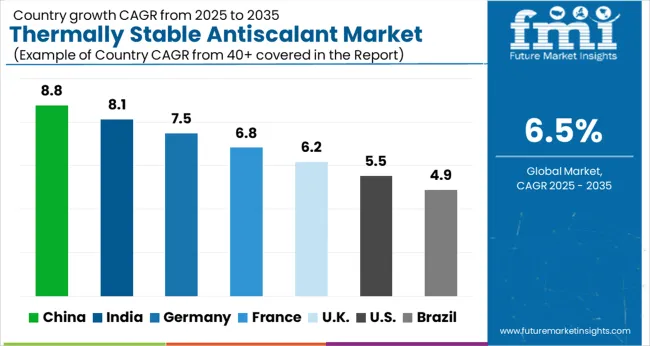
| Country | CAGR |
|---|---|
| China | 8.8% |
| India | 8.1% |
| Germany | 7.5% |
| France | 6.8% |
| UK | 6.2% |
| USA | 5.5% |
| Brazil | 4.9% |
The Thermally Stable Antiscalant Market is expected to register a CAGR of 6.5% during the forecast period, exhibiting varied country level momentum. China leads with the highest CAGR of 8.8%, followed by India at 8.1%. Developed markets such as Germany, France, and the UK continue to expand steadily, while the USA is likely to grow at consistent rates. Brazil posts the lowest CAGR at 4.9%, yet still underscores a broadly positive trajectory for the global Thermally Stable Antiscalant Market. In 2024, Germany held a dominant revenue in the Western Europe market and is expected to grow with a CAGR of 7.5%. The USA Thermally Stable Antiscalant Market is estimated to be valued at USD 435.8 million in 2025 and is anticipated to reach a valuation of USD 746.2 million by 2035. Sales are projected to rise at a CAGR of 5.5% over the forecast period between 2025 and 2035. While Japan and South Korea markets are estimated to be valued at USD 64.1 million and USD 33.8 million respectively in 2025.
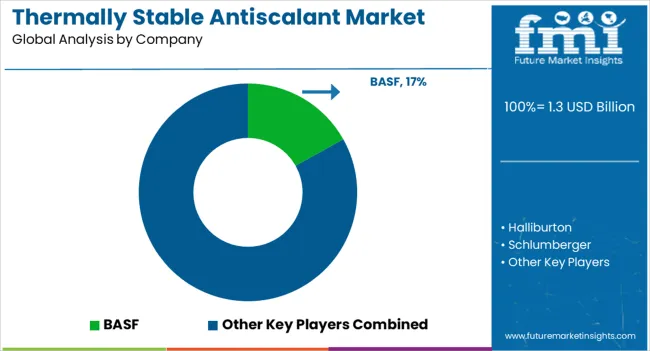
| Item | Value |
|---|---|
| Quantitative Units | USD 1.3 Billion |
| Type | Thermally stable organic antiscalant and Thermally stable inorganic antiscalant |
| Application | Water and waste water treatment, Oil and Gas, Mining, Food And Beverages, Pharmaceutical, and Others |
| Regions Covered | North America, Europe, Asia-Pacific, Latin America, Middle East & Africa |
| Country Covered | United States, Canada, Germany, France, United Kingdom, China, Japan, India, Brazil, South Africa |
| Key Companies Profiled | BASF, Halliburton, Schlumberger, Dow Chemical Company, Nalco(Ecolab), AkzoNobel NV, Accepta, Kemira Oyj, BWA Water Additives, and Yangzhou Runda Oilfield Chemicals |
The global thermally stable antiscalant market is estimated to be valued at USD 1.3 billion in 2025.
The market size for the thermally stable antiscalant market is projected to reach USD 2.4 billion by 2035.
The thermally stable antiscalant market is expected to grow at a 6.5% CAGR between 2025 and 2035.
The key product types in thermally stable antiscalant market are thermally stable organic antiscalant and thermally stable inorganic antiscalant.
In terms of application, water and waste water treatment segment to command 36.2% share in the thermally stable antiscalant market in 2025.






Our Research Products

The "Full Research Suite" delivers actionable market intel, deep dives on markets or technologies, so clients act faster, cut risk, and unlock growth.

The Leaderboard benchmarks and ranks top vendors, classifying them as Established Leaders, Leading Challengers, or Disruptors & Challengers.

Locates where complements amplify value and substitutes erode it, forecasting net impact by horizon

We deliver granular, decision-grade intel: market sizing, 5-year forecasts, pricing, adoption, usage, revenue, and operational KPIs—plus competitor tracking, regulation, and value chains—across 60 countries broadly.

Spot the shifts before they hit your P&L. We track inflection points, adoption curves, pricing moves, and ecosystem plays to show where demand is heading, why it is changing, and what to do next across high-growth markets and disruptive tech

Real-time reads of user behavior. We track shifting priorities, perceptions of today’s and next-gen services, and provider experience, then pace how fast tech moves from trial to adoption, blending buyer, consumer, and channel inputs with social signals (#WhySwitch, #UX).

Partner with our analyst team to build a custom report designed around your business priorities. From analysing market trends to assessing competitors or crafting bespoke datasets, we tailor insights to your needs.
Supplier Intelligence
Discovery & Profiling
Capacity & Footprint
Performance & Risk
Compliance & Governance
Commercial Readiness
Who Supplies Whom
Scorecards & Shortlists
Playbooks & Docs
Category Intelligence
Definition & Scope
Demand & Use Cases
Cost Drivers
Market Structure
Supply Chain Map
Trade & Policy
Operating Norms
Deliverables
Buyer Intelligence
Account Basics
Spend & Scope
Procurement Model
Vendor Requirements
Terms & Policies
Entry Strategy
Pain Points & Triggers
Outputs
Pricing Analysis
Benchmarks
Trends
Should-Cost
Indexation
Landed Cost
Commercial Terms
Deliverables
Brand Analysis
Positioning & Value Prop
Share & Presence
Customer Evidence
Go-to-Market
Digital & Reputation
Compliance & Trust
KPIs & Gaps
Outputs
Full Research Suite comprises of:
Market outlook & trends analysis
Interviews & case studies
Strategic recommendations
Vendor profiles & capabilities analysis
5-year forecasts
8 regions and 60+ country-level data splits
Market segment data splits
12 months of continuous data updates
DELIVERED AS:
PDF EXCEL ONLINE
Stable Cell Line Development Market Size and Share Forecast Outlook 2025 to 2035
Stable Angina Management Market Analysis by Drug Class, Distribution Channel, and Region: Forecast for 2025 to 2035
Antiscalants and Dispersants Market Analysis by Product, End-use, and Region 2025 to 2035
Unstable Angina Therapeutics Market Insights - Size, Share & Forecast 2025 to 2035
Nestable Drums Market Insights – Growth & Forecast 2024 to 2034
Adjustable Gripping Hand Tools Market
Compostable Pouch Market Size and Share Forecast Outlook 2025 to 2035
Compostable Foodservice Packaging Market Size and Share Forecast Outlook 2025 to 2035
Compostable Packaging Equipment Market Size and Share Forecast Outlook 2025 to 2035
Compostable Adhesives Market Analysis - Size and Share Forecast Outlook 2025 to 2035
Compostable Packaging Films Market Size and Share Forecast Outlook 2025 to 2035
Compostable Tableware Market Size and Share Forecast Outlook 2025 to 2035
Compostable Straws Market Growth - Demand & Forecast 2025 to 2035
Compostable Food Trays Market Size and Share Forecast Outlook 2025 to 2035
Compostable Plastic Packaging Material Market from 2025 to 2035
Compostable Toothbrush Market Growth & Forecast 2025 to 2035
Bake Stable Pastry Fillings Market Analysis by Product, Distribution Channel, and Region Through 2035
Market Positioning & Share in the Compostable Food Trays Industry
Market Share Insights of Compostable Foodservice Packaging Providers
Leading Providers & Market Share in the Compostable Toothbrush Industry

Thank you!
You will receive an email from our Business Development Manager. Please be sure to check your SPAM/JUNK folder too.
Chat With
MaRIA